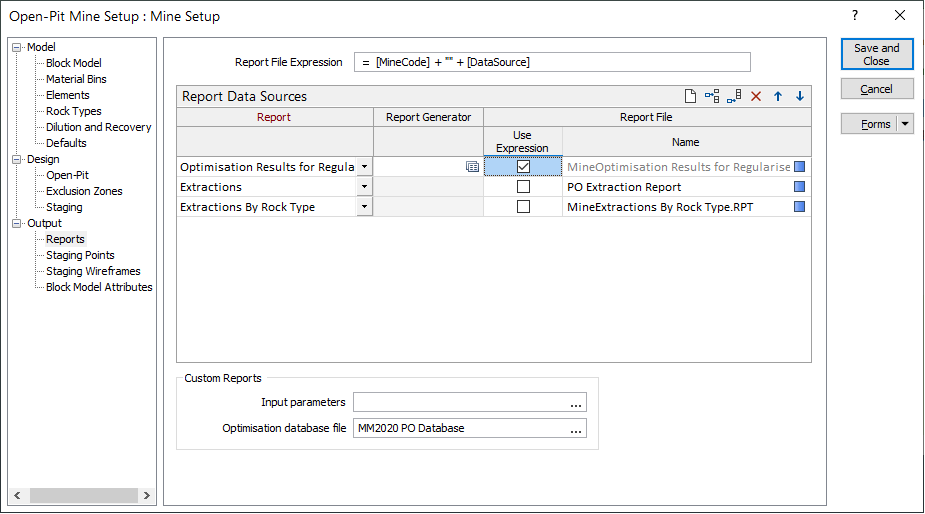Reports
Use the Output > Reports tab to generate detailed report file, select data sources for the reports you want to generate, and specify the names of the files in which those reports are to be saved:

Report File Expression
(Optional.) In the Report File Expression box, specify the expression to be used to generate the names of the Report files. Click the buddy button on the left-hand side of the field to invoke the Expression Editor. See: Report File Expression
Report Data Sources
Specify the following settings for each data source to be reported:
Report
The Optimiser can generate detailed report files from one or more data sources. Select the name of the data source to be reported for each report. See: Report Data Sources
Report Generator
![]() (Optional.) Click the right mouse button on the buddy button on the right-hand side of the field and select the New or Edit option to specify the name of the form set to be used to configure the Report Generator to process the data source.
(Optional.) Click the right mouse button on the buddy button on the right-hand side of the field and select the New or Edit option to specify the name of the form set to be used to configure the Report Generator to process the data source.
The data source will be processed by the Report Generator and the result will be saved in the specified Report file.
Report file
Specify the name of the file in which the report for the data source is to be saved:
Use Expression
(Optional.) Select this option to indicate that the name of the report file for the data source is to be generated using the expression specified in Report File Expression.
Name
(Use Expression selected.) The name, as generated from Report File Expression, of the file in which the report for the data source is to be saved will be displayed in grey here. You can edit this name. If you do so, Use Expression will be deselected automatically and the name that you enter will be used as the name of the file.
(Use Expression not selected.) Enter the name of the file in which the report for the data source is to be saved.
Click the right mouse button on the Select icon on the right-hand side of the field and select the appropriate option to view or process the last report that was generated.
Export to Microsoft Excel Workbook (Spreadsheet)
By default, all reports are saved in Micromine REPORT files, to which the .RPT filename extension is assigned. However, it is also possible to save them in Microsoft Excel workbook files (.xlsx).
After the report has been generated, click the right mouse button on the Select icon on the right-hand side of the Report File > Name field and select the Edit option to open the report in the File Editor. Then select the File | Export to Excel option to export the report to either a Microsoft Excel workbook file (.xlsx) or in comma-separated values (CSV) format.
Custom Reports
Specify the names for the optional output files:
Input parameters
(Optional.) Specify the name of the Microsoft Excel workbook in which a summary of the parameters for the optimisation run is to be saved. The .xlsx filename extension is used to identify these files.
Optimisation database file
(Optional.) Specify the name of the database file in which the optimisation results are to be saved.
The optimisation database file stores detailed results from the optimisation for use in subsequent analysis and charting. The .podb filename extension is used to identify these files.
This file can be used with the Stope/Pit Optimiser | Analyse Stopes/Pits options (for which it is optional) and the Stope/Pit Optimiser | Stope/Pit Results Chart options (for which it is required).